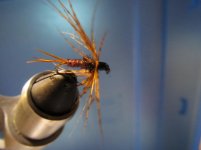tomfly
The only thing left should be foot prints.
Hook: standard nymph hook I used (Mustad 3906B)
Thread: Black: 6/0
Under Body: Bright Red 10/0 thread
Over body: 3 Pheasant tail fibers. Sparely wrapped to allow under body to show
Thorax: Red dyed Peacock herl
Tail: 3 Biots from a Burnt Orange dyed Hungarian partridge primary wing feather
Hackle: Burnt Orange Dyed Hungarian partridge breast feather.

